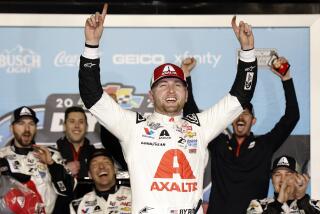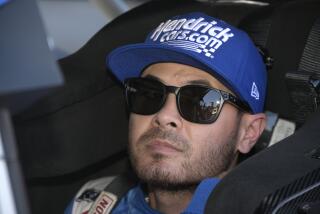Sadler, Gordon Take Twins
- Share via
DAYTONA BEACH, Fla. — Elliott Sadler and Jeff Gordon won the twin qualifying races Thursday that completed the field for Sunday’s Daytona 500, while several other drivers -- and NASCAR itself -- also scored victories of sorts.
They included Dale Earnhardt Jr., who finished third behind Sadler and runner-up Carl Edwards in the opening 150-mile race at Daytona International Speedway, even though he had to start in back because of a last-minute engine change.
Another was Jimmie Johnson, who claimed fourth behind Earnhardt even though he also started in the rear and was driving without his crew chief, Chad Knaus.
NASCAR sent Knaus home this week for illegally altering the rear-window aerodynamics of Johnson’s No. 48 Chevrolet during last Sunday’s initial qualifying for the two front spots in the 500.
Robby Gordon, who narrowly missed qualifying for last year’s Daytona 500, got his Chevy into “the Great American Race” this time. He’ll start 20th.
And NASCAR avoided having to debut its controversial new penalties for “bump-drafting,” as all the drivers showed restraint, compared with their behavior in the wild Budweiser Shootout sprint last Sunday.
“Nobody wanted to take a chance” of either incurring NASCAR’s wrath or damaging their cars with aggressive bump-drafting, said Sadler, who drives a Ford Fusion, making its NASCAR debut this season, for Robert Yates Racing. “I didn’t see a lot of it.”
Jeff Burton put his Richard Childress Chevrolet on the pole for the Daytona 500 last Sunday and Gordon was second in a Hendrick Motorsports Chevy. Sadler will start third and Kyle Busch, driving a Dodge for Penske Racing South, fourth.
The rest of the 43-car field was determined by the results of the qualifying races, which were delayed an hour because of light rain.
But most of NASCAR’s big names already were assured of a spot in the Daytona 500, regardless of how they qualified. Rules imposed last year guaranteed starting positions to the top 35 cars, based on their owners’ points in the previous season.
The issue of bump-drafting took center stage Sunday night when, after the non-points Budweiser Shootout, defending Nextel Cup Champion Tony Stewart bitterly complained that the practice was “out of control” and endangering the drivers.
Bump-drafting occurs when a driver pushes his car’s nose into the car ahead of him in hopes of moving them both forward. But the move also can upset the forward car, causing a crash.
It’s a common technique at tracks such as Daytona and Talladega, where the cars travel in packs. But after Stewart complained, NASCAR said it would start policing the drivers and would levy penalties if warranted.
“It would be better if NASCAR was not involved with this, because it will be a subjective call, it’s a gray area,” NASCAR President Mike Helton told the drivers in their pre-race meeting.
But he warned them that if a driver were penalized, there would be no appeal.
“If we make the call, it’s over with,” he said, adding that NASCAR’s police action “isn’t as much about bump-drafting as it is about aggressive driving.”
It became a moot point Thursday, however, as the drivers took a more conservative stance.
That didn’t surprise many drivers, who noted that the emphasis Thursday was on saving the cars for the biggest prize, the Daytona 500.
“The racing was still good, but yet it was so much calmer,” said Jeff Gordon, who won from the pole and appears to have one of the strongest cars for the 500.
But they also said the threat of penalties didn’t reduce the drivers’ intensity.
“We’ll still run into each other, because that’s what we do,” Earnhardt said.
Stewart declined to push the controversy further.
“I’m not going to stand here for 10 minutes and go over comparisons” between bump-drafting in the Shootout and in the qualifying races, he said. “We’ve got a lot of work to do for Sunday.”
Sadler led 36 of the 60 laps in the first qualifying race; Gordon led 38 of the laps in his heat.
Robby Gordon, who owns his team, finished 10th in the second race to make the 500.
“It’s a long ways from where we were a year ago,” he said, referring to his failure to qualify in 2005.
More to Read
Go beyond the scoreboard
Get the latest on L.A.'s teams in the daily Sports Report newsletter.
You may occasionally receive promotional content from the Los Angeles Times.










